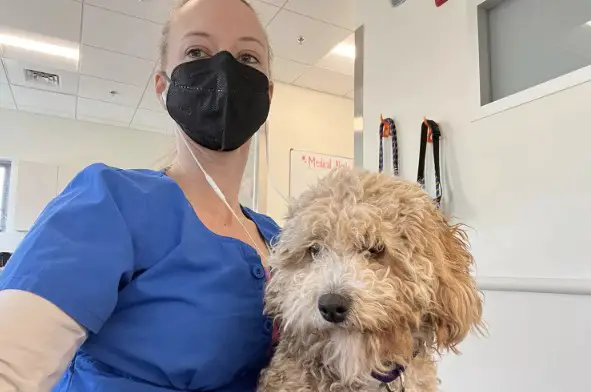Lolly thinks that dogs help dogs throughout the world.
The innocent dog was one among more than 500 pups that the ASPCA saved from appalling conditions at an Iowa puppy mill in November 2021. She is now a “support dog” at the ASPCA Behavioral Rehabilitation Center (BRC) in Weaverville, North Carolina, where she aids timid canines in navigating novel situations.
The ASPCA removed Lolly from the Iowa breeding facility last year, beginning Lolly’s transformation from “nervous” puppy mill rescue to heroic aid dog. Lolly was sent to an ASPCA-run emergency facility for initial examinations and treatment after being saved.
During her initial physical examination, Lolly was found to have matted fur, intestinal parasites, dental issues, and a serious illness, according to the ASPCA. Lolly was moved to the BRC to address her avoidant conduct toward human contact and walking on a leash after getting treatment for these problems.

According to Darren Young, CPDT-KA, Lolly’s behavioral rehabilitation specialist at the BRC, “The BRC is the first-ever permanent facility dedicated to the study and behavioral rehabilitation of canine victims of cruelty and neglect. After being rescued from the Iowa puppy mill, Lolly needed support with her fear and under socialization, so she came to the BRC for treatment.”
Young continues, “At first, Lolly was anxious and pacing, her anxiousness even causing her paw pads to sweat.”
“After six weeks, Lolly was ready for ‘graduation.’ She was enjoying spending time with people, car rides, and exploring local parks,” he adds.
Today, Lolly lives with her forever family, which includes Dr. Ashley Eisenback, DVM, the senior director of veterinary services at the BRC.

Dr. Eisenback met Lolly at the BRC when the dog was approaching graduation and needed a vet visit to address overgrown fur near her eyes.
Dr. Eisenback decided to adopt Lolly, who quickly made herself comfortable with her new family.
A year after her rescue, Lolly no longer needs the BRC’s services, but she still visits the center often.
At the BRC, helper dogs encourage fearful dogs to explore and enjoy new experiences.

“Helper dogs can act as guides, showing a fearful dog how to walk on a leash, jump into a car, or even how to happily engage in play. The helper dog often gives the fearful dogs the confidence they need to interact with people and their environment. This, in turn, helps them to feel more relaxed and allows their personalities to blossom,” Young explains.
Even the rescue dogs that don’t come through the BRC benefit from Lolly’s recovery because the dog’s success shows that all neglected animals deserve a second chance.
“Dogs are very resilient when we are patient with them. Fearful dogs can become wonderful companions with patience and understanding,” Dr. Eisenback says.
The ASPCA’s BRC encourages everyone to fight for the dogs in commercial breeding facilities and hold the USDA accountable for protecting those animals. If you are located in Western North Carolina or the surrounding area and are interested in adopting an animal from the ASPCA Behavioral Rehabilitation Center, visit the ASPCA’s adoption website and view the adoptable dogs in North Carolina.
Source: People









